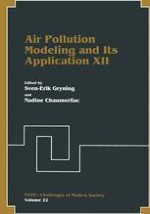1998 | OriginalPaper | Buchkapitel
Intercomparison of Two Long-Range Lagrangian Particle Models with ETEX Tracer Data
verfasst von : F. Desiato, D. Anfossi, S. Trini Castelli, E. Ferrero, G. Tinarelli
Erschienen in: Air Pollution Modeling and Its Application XII
Verlag: Springer US
Enthalten in: Professional Book Archive
Aktivieren Sie unsere intelligente Suche, um passende Fachinhalte oder Patente zu finden.
Wählen Sie Textabschnitte aus um mit Künstlicher Intelligenz passenden Patente zu finden. powered by
Markieren Sie Textabschnitte, um KI-gestützt weitere passende Inhalte zu finden. powered by
The first European long-range tracer experiment (ETEX), jointly organised by the European Commission, the World Meteorological Organisation and the International Atomic Energy Agency, took place on October 23, 1994. The aim of the experiment was to simulate an emergency situation following a release of harmful material into the atmosphere, and to test both real-time and a-posteriori modeling capabilities of reproducing in space and time the tracer concentration field. An inert tracer (perfluoromethylcyclohexane, a perfluorocarbon compound) was released near Rennes, in Northwest France, for twelve hours starting form 16 h UTC, and sampled at three-hourly intervals by 168 ground sites up to a distance of about 2000 km. The synoptic situation at the beginning of the release was characterised by a deep low east of Scotland slowly moving North, maintaining a strong flow from west-southwest in the lower layers over the release site. This condition, together with the correct forecast of its evolution for the following three days, yielded a large number of sampling stations, sparse over Central and Northern Europe, detecting concentrations above background, and so determined the success of the experiment. The concentration data set constitutes the base for both real-time and a-posteriori model evaluations. We present here an a-posteriori intercomparison between two Lagrangian particle models (APOLLO, developed at ANPA, and MILORD, developed at CNR-ICG) simulations of ETEX.
